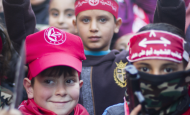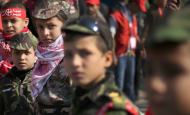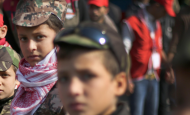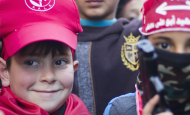UN Report on “Children and Armed Conflict”: Moving the Goalposts on Israel
The United Nations Secretary-General published the annual report on “grave violations” in the context of children and armed conflict for 2020 (dated May 6, 2021). It is scheduled to be presented to the UN Security Council on June 28, 2021.
Every year, the Secretary-General compiles and publishes a list, in the form of an annex to his report, of the worst state and non-state violators of children’s rights. Triggering violations include attacks on schools and hospitals, killing and maiming, recruitment and use of child soldiers, sexual assault, and/or abduction of children. Being listed in the Annex can result in Security Council sanctions. (NGO Monitor’s analyses of previous CAAC reports are available here.)
As in previous years, “Israel and the State of Palestine” appears among “situations on the agenda of the Security Council.” However, despite an intense NGO campaign, the IDF does not appear in the annex of grave violators.
The report claims that “the United Nations verified 1,031 grave violations against 340 Palestinian and 3 Israeli children (327 boys, 13 girls) in the occupied West Bank, including East Jerusalem, the Gaza Strip and Israel.” In addition, for the first time, the UN explicitly considers tear gas inhalation to be a form of “maiming.”
Although the report refers to UN verification of the claims, NGO Monitor research shows that, in the Israeli context, the allegations primarily originate with a group of radical NGOs that belong to a “working group” tasked by UNICEF with monitoring and advocacy on children’s issues. Together with UNICEF, they engage in a campaign to demonize Israel in the Secretary-General’s annual report and seek to have Israel added to the Annex.
The relatively large number of NGOs active in the Palestinian-Israeli conflict – enabled by significant funding from the EU, European governments, and others – leads to a selection bias: UN receives and reports a high number of allegations against Israel because of NGO engagement. Grave violations that occur in places with less NGO presence are underreported.
Double standards
According to the UN, the grave violation of “maiming” constitutes “Any action that causes a serious, permanent, disabling injury, scarring or mutilation to a child.” Consistent with this definition, throughout the report, “maiming” refers to “air strikes”; “targeted killings”; “suicide and complex attacks”; “gunshots”; “landmines”; “shelling”; “improvised explosive devices”; “torture”; “explosive remnants of war”; and “crossfire.”
Except with regards to Israel.
In the report, the primary cause of “maiming of children by Israeli forces” is tear gas (more than 50% of incidents), without any account of the severity of medical intervention, if any, needed for the cases. Reflecting the singular application to Israel, the UN only references its definition of maiming in this context (fn. 12), but without explaining how tear gas is relevant to this definition.
Indeed, tear gas uniquely appeared in the Israel section in the 2019 report, as well.
However, in that year, the Secretary-General’s report listed tear gas inhalation as “injuries” distinct from “maiming.” In a July 2019 press conference, UN Special Representative for Children and Armed Conflict Virginia Gamba acknowledged this distinction and indicated that her office was going to examine expanding the definition of “maiming” to include tear gas.
Including non-violations
- In its narrative about Israel, the third paragraph is on “the detention of 361 Palestinian children for alleged security offenses” and highlights “reported ill-treatment and breaches of due process by Israeli forces.” The placement and language used by the UN suggest that these are some of the 1,031 grave violations discussed in the section.
However, detention of children – a major theme of NGO advocacy to demonize Israel, such as the work of PFLP-linked Defense for Children International-Palestine (DCIP) in conjunction with UNICEF – is not a grave violation in the CAAC framework.
If anything, the Palestinian minors in question were arrested for violent crimes, including terror offenses and attempted murder. Yet, the UN does not condemn the incitement within their communities that inspires such attacks.
- The UN also includes incidents of “94 other interferences with health (5) or education (89) by Israeli forces (90),” specifically “Israeli force closures or denial of teachers’ and students’ access through checkpoints (39), Israeli forces firing tear gas or other weapons in and around schools (22), or threats of demolition [of schools] (9).” These are not considered “attacks on schools or hospitals,” and are therefore are listed “separately” (but within the same paragraph as the former).
The inclusion of such allegations, where the connection to a school is incidental or a question of the structure’s legality, reflects another aspect of NGO influence. As shown by NGO Monitor, NGOs use an invented term “attacks on education” to bolster their campaigns to sanction Israel through the annual CAAC report.
Inflating the number of violations
Approximately 64% (659) of the “verified 1,031 grave violations” involve children in Gaza who allegedly could not enter Israel for medical treatment (scant details or references are provided to verify this claim). Regardless, contrary to the UN’s premise, Israel is not obligated to allow residents of Gaza into Israel for medical treatment (or any other reason).





